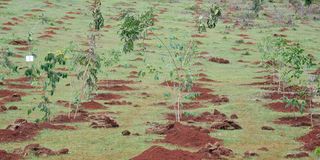Hope for forest as locals warm up to biogas energy

What you need to know:
- WWF champions use of clean energy and tree planting as part of the efforts to save Kaptagat Forest
- KFS to distribute 40,000 exotic trees to locals in the area
- So far, about 860 hectares have been rehabilitated
Fred Kibet, a resident of Koibarak village at the border of Uasin Gishu and Elgeyo-Marakwet counties, has been relying on the Kaptagat Forest that borders his home to get firewood, oblivious to the fact that his actions have been eating up the forest.
He is among 20 people involved in a biogas pilot project that started last year with the aim of promoting the use of clean energy.
The biogas project is being spearheaded by the World Wide Fund (WWF) as part of its measures to improve the access to clean sources of energy and curb over-reliance on trees.
“We used to collect 20 to 30 kilos of firewood from the forest (per single trip). That is equivalent to one or two trees. This used to last us two to three days,” he recalls, as he checks on his dairy cows.
From the six cows he rears, he gets animal waste that he uses to generate biogas for fuel.
The project also sensitises locals to engage in tree-planting and in the protection of the natural resource.
“With the biogas project, we no longer require firewood from the forest. We are now actively working to grow trees and protect this resource,” explains Mr Kibet.
Kaptagat Forest, which forms part of the Cherangany water catchment, is the source of water for most residents in the North Rift region that includes Eldoret Town and the Kerio River water basin.
Mr Jackson Kiplagat, the head of conservation programmes at World Wide Fund Kenya, noted that the biogas project is a pilot targeting to benefit more than 1,000 individuals indirectly in the 21 sub-locations surrounding the Kaptagat Forest ecosystem to guarantee clean energy in homes and boost the forest cover.
Environment Principal Secretary Chris Kiptoo, who presided over the biogas project, says that since 2017, a number of projects have been initiated to rehabilitate the forest that is a source of water used in more than 10 counties.
So far, 859 hectares have been rehabilitated through the greening initiative in collaboration with various stakeholders, including athletes.
Renowned marathoner Eliud Kipchoge has adopted 50.8 hectares.
Dr Kiptoo explains that they are in the process of rehabilitating 1,000 hectares which were yet to be restored.
“Grazing has been a big driver of the degradation and there were no consistent measures to re-plant trees. We are on a serious mission to rehabilitate this ecosystem,” he says.
Kaptagat landscape continues to face unsustainable agricultural practices, illegal logging, overgrazing, forest encroachment and charcoal production. However, the Greening Kaptagat Project aims to mitigate these threats by restoring over 1,000 hectares.
Dr Kiptoo observes that the user rights – as prescribed in the current law – allow locals to access the natural resource but call for greater responsibility to ensure proper protection.
Some of the forests that have been restored include the Penon and Sibor in the Charangany ecosystem.
Dr Kiptoo is appealing to all counties to actively support the programmes to rehabilitate forests.
“The law allows them to access the forest but it doesn’t let them allow their livestock to move aimlessly and damage trees. We are also asking them to practise good agricultural practices to prevent soil erosion because we want clean water,” he explains.
Early this year, the Greening Kaptagat Project in Elgeyo Marakwet, which is tasked with restoring deforested and degraded land, received Sh800 million from a partnership between the UK, World Wide Fund and the Eliud Kipchoge Foundation.
Clean water
Mr Kiplagat said that the more than 800 residents now have access to clean water following the launch of the Kapkoi-Kibogy solar-powered project in February through the Greening Kaptagat Project.
“This project tackled climate change by addressing carbon emissions from deforestation, forest degradation and unsustainable practices,” observes Mr Kiplagat.
Mr Antony Musyoka, a conservator with the Kenya Forest Service (KFS) in the North Rift, notes that they are targeting to distribute 40,000 exotic trees to locals within part of the Cherangany ecosystem.
“We are urging everyone to take care of this ecosystem because it is a source of water and medicine,” says Mr Musyoka.
According to the National Forest Resources Assessment Report released by KFS in July, counties with the highest forest cover percentage include Nyeri (40.89), Lamu (32.13), Kilifi (26.25), Nyandarua (26.2) and Bomet (24.28) while counties with the lowest forest cover percentage include Siaya (0.23), Migori (0.31), Busia (0.56), Wajir (0.98) and Marsabit (1.11).
Counties with the highest tree cover percentage include Nyeri (45.17), Lamu (44.06), Vihiga (35.92), Kirinyaga (30.39) and Elgeyo Marakwet (29.95) while counties with the lowest tree cover percentage include Marsabit (2.06), Mandera (3.61), Wajir (4.45), Siaya (5.27) and Machakos (6.03).



